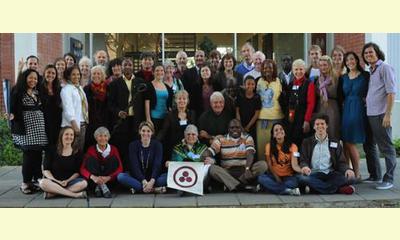|
|
Switzerland 2013: Nesting Peace - Sixth Summit of the Global Alliance for Ministries and Infrastructures for Peace
un articulo por Global Alliance for Ministries & Infrastructures for Peace (abridged)
Nesting Peace is the Sixth Summit of the Global
Alliance for Ministries and Infrastructures for
Peace (Geneva, September 16-20, 2013), a worldwide
community of individuals in civil society,
business and government who work toward a Culture
of Peace by promoting the development of
infrastructures for peace at various levels.

click on photo to enlarge
The traditional or liberal peacebuilding paradigm is
in crisis. Infrastructures for peace provide a
much-needed alternative and effective framework for
peacebuilding.
Infrastructures for peace are social structures
that support and facilitate the manifold processes
of peace. These include dialogue, reconciliation,
mediation, peace education, restorative justice,
and many others. They need to be carried out with
continuity, supported socially, and engaged by all
stakeholders, starting at the local level. This is
made possible by infrastructures for peace, which
function as the implementing mechanisms or
enabling environments of peace. They take the form
of restorative circle systems, local peace
committees, national Ministries for Peace, peace
academies, peace museums, among others.
This Summit grows out of and has a role to play at
an important moment in the history of
infrastructures for peace. Just in the last 12
years, the world has seen the creation of the
first four Ministries for Peace, as well as
Offices, Departments and other institutions for
the promotion of peace within governments. Outside
of government, countless more infrastructures for
peace have been developed by civil society around
the world, including with the support of the
United Nations Development Program and many other
actors. These experiences are the object of
several studies that will be published in 2013,
marking the coming of age of this concept. This
Summit will thus provide the space to share these
developments and their impact, focusing on both
successes and challenges.
In order to effectively contribute to this
momentum, however, we will do more than share. The
Summit, largely organized by youth, will be
designed to connect participants in innovative
ways in order to catalyze engagement. In fact, the
Summit aims to be an infrastructure for peace
itself as it demonstrates the processes that a
social group experiences within these kinds of
infrastructures. Restorative circles, peace
resource corners, empathy sessions and artistic
exhibits are just some examples of what will be
available to engage with. Indeed, we believe that
experience and co-creation enables the kind of
transformative learning necessary for the work of
peace. We also believe that diversity is the best
guarantee of the sustainability of peace. The
Summit will take advantage of Geneva’s unique
character to gather a heterogeneous group of
actors, coming from governments, civil society
organizations, the United Nations system,
academia, business, youth, artists, the justice
system, religious groups, indigenous peoples, the
police and others. This year the Summit program
will also include a high-level government segment
on the topic. In addition, a special effort will
be made to ensure that financial factors be not an
impediment to the participation of individuals. .
.
We invite you to be part of this. Click here for
information on registration.
(Click here for a French version of this article)
|








|
DISCUSSION
Pregunta(s) relacionada(s) al artículo :
Can the culture of peace be established at the level of the state?,
* * * * *
Comentario más reciente:
:
The state has come, over the centuries, to monopolize the culture of war. It would require a radical change in its very nature for it to abandon the culture of war and adopt a culture of peace.
For details on how the state has come to monopolize the culture of war, see The History of the Culture of War

|
|









